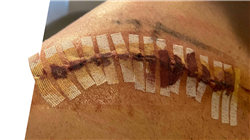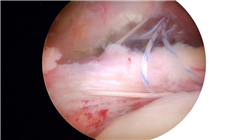University certificate
The world's largest faculty of medicine”
Introduction to the Program
You will delve into the most important advances in Shoulder Surgery , keeping you with TECH at the forefront of this specialty"

Due to the high incidence of shoulder injuries, especially in the rotator cuff, and their impact on the quality of life of those affected, minimally invasive procedures, surgical techniques and prostheses have been improved in recent years. These advances are accompanied by a constant updating of specialists interested in integrating the most notable advances into their practice.
In this sense, TECH has developed this program, which will allow the professional to have an update on the latest diagnostic advances, as well as therapeutic procedures applied in Shoulder Surgery .
Throughout 12 months of intensive updating, the doctor will explore in depth the different access routes to be used for open surgery, the different arthroscopic entrances and the applied anatomy. In addition, it will delve into the main indications for various radiological techniques such as conventional radiography, computed tomography and arthroCT. To do so, you will have a wide variety of multimedia resources or clinical case studies that will show you various situations you might encounter in your daily practice.
Following this approach, the program is presented in a 100% online format, which will provide the graduate with the possibility to reconcile his or her daily activities with those of updating his or her knowledge. In addition, this methodology combined with the Relearning method will allow you to deepen your knowledge by remembering the most relevant concepts in less time and without investing long hours of study.
With TECH, you will delve into the key points of Shoulder Surgery and improve your surgical skills in this highly specialized area"
This Professional master’s degree in Shoulder Surgery contains the most complete and up-to-date scientific program on the market. The most important features include:
- The development of case studies presented by expert orthopedic surgeons
- The graphic, schematic, and practical contents with which they are created, provide scientific and practical information on the disciplines that are essential for professional practice
- Practical exercises where self-assessment can be used to improve learning
- Its special emphasis on innovative methodologies
- Theoretical lessons, questions to the expert, debate forums on controversial topics, and individual reflection assignments
- Content that is accessible from any fixed or portable device with an Internet connection
In just 12 months you will explore in detail the osteology of the shoulder and update the knowledge necessary to perform successful implants”
The program’s teaching staff includes professionals from sector who contribute their work experience to this educational program, as well as renowned specialists from leading societies and prestigious universities.
Its multimedia content, developed with the latest educational technology, will provide the professional with situated and contextual learning, i.e., a simulated environment that will provide an immersive education programmed to learn in real situations.
The design of this program focuses on Problem-Based Learning, by means of which the professional must try to solve the different professional practice situations that are presented throughout the academic course. For this purpose, the student will be assisted by an innovative interactive video system created by renowned experts.
With this Professional master’s degree program you will learn about arthrology and the ligaments of the shoulder, expanding your clinical skills"

He implements the different techniques of shoulder approach and acquires skills in minimally invasive procedures"
Why study at TECH?
TECH is the world’s largest online university. With an impressive catalog of more than 14,000 university programs available in 11 languages, it is positioned as a leader in employability, with a 99% job placement rate. In addition, it relies on an enormous faculty of more than 6,000 professors of the highest international renown.

Study at the world's largest online university and guarantee your professional success. The future starts at TECH”
The world’s best online university according to FORBES
The prestigious Forbes magazine, specialized in business and finance, has highlighted TECH as “the world's best online university” This is what they have recently stated in an article in their digital edition in which they echo the success story of this institution, “thanks to the academic offer it provides, the selection of its teaching staff, and an innovative learning method aimed at educating the professionals of the future”
A revolutionary study method, a cutting-edge faculty and a practical focus: the key to TECH's success.
The most complete study plans on the university scene
TECH offers the most complete study plans on the university scene, with syllabuses that cover fundamental concepts and, at the same time, the main scientific advances in their specific scientific areas. In addition, these programs are continuously being updated to guarantee students the academic vanguard and the most in-demand professional skills. In this way, the university's qualifications provide its graduates with a significant advantage to propel their careers to success.
TECH offers the most comprehensive and intensive study plans on the current university scene.
A world-class teaching staff
TECH's teaching staff is made up of more than 6,000 professors with the highest international recognition. Professors, researchers and top executives of multinational companies, including Isaiah Covington, performance coach of the Boston Celtics; Magda Romanska, principal investigator at Harvard MetaLAB; Ignacio Wistumba, chairman of the department of translational molecular pathology at MD Anderson Cancer Center; and D.W. Pine, creative director of TIME magazine, among others.
Internationally renowned experts, specialized in different branches of Health, Technology, Communication and Business, form part of the TECH faculty.
A unique learning method
TECH is the first university to use Relearning in all its programs. It is the best online learning methodology, accredited with international teaching quality certifications, provided by prestigious educational agencies. In addition, this disruptive educational model is complemented with the “Case Method”, thereby setting up a unique online teaching strategy. Innovative teaching resources are also implemented, including detailed videos, infographics and interactive summaries.
TECH combines Relearning and the Case Method in all its university programs to guarantee excellent theoretical and practical learning, studying whenever and wherever you want.
The world's largest online university
TECH is the world’s largest online university. We are the largest educational institution, with the best and widest online educational catalog, one hundred percent online and covering the vast majority of areas of knowledge. We offer a large selection of our own degrees and accredited online undergraduate and postgraduate degrees. In total, more than 14,000 university degrees, in eleven different languages, make us the largest educational largest in the world.
TECH has the world's most extensive catalog of academic and official programs, available in more than 11 languages.
Google Premier Partner
The American technology giant has awarded TECH the Google Google Premier Partner badge. This award, which is only available to 3% of the world's companies, highlights the efficient, flexible and tailored experience that this university provides to students. The recognition as a Google Premier Partner not only accredits the maximum rigor, performance and investment in TECH's digital infrastructures, but also places this university as one of the world's leading technology companies.
Google has positioned TECH in the top 3% of the world's most important technology companies by awarding it its Google Premier Partner badge.
The official online university of the NBA
TECH is the official online university of the NBA. Thanks to our agreement with the biggest league in basketball, we offer our students exclusive university programs, as well as a wide variety of educational resources focused on the business of the league and other areas of the sports industry. Each program is made up of a uniquely designed syllabus and features exceptional guest hosts: professionals with a distinguished sports background who will offer their expertise on the most relevant topics.
TECH has been selected by the NBA, the world's top basketball league, as its official online university.
The top-rated university by its students
Students have positioned TECH as the world's top-rated university on the main review websites, with a highest rating of 4.9 out of 5, obtained from more than 1,000 reviews. These results consolidate TECH as the benchmark university institution at an international level, reflecting the excellence and positive impact of its educational model.” reflecting the excellence and positive impact of its educational model.”
TECH is the world’s top-rated university by its students.
Leaders in employability
TECH has managed to become the leading university in employability. 99% of its students obtain jobs in the academic field they have studied, within one year of completing any of the university's programs. A similar number achieve immediate career enhancement. All this thanks to a study methodology that bases its effectiveness on the acquisition of practical skills, which are absolutely necessary for professional development.
99% of TECH graduates find a job within a year of completing their studies.
Professional Master's Degree in Shoulder Surgery
Shoulder surgery plays a vital role in modern medical care, providing effective solutions to injuries and conditions that affect this important joint. Aware of the growing demand for highly trained professionals in this area, TECH Global University of Technology presents its Professional Master's Degree in Shoulder Surgery, a cutting-edge program with online classes designed to take your career in medicine to the next level. Our online classes offer a flexible and convenient educational experience, allowing you to access program content from anywhere and at any time that fits your schedule. This mode gives you the freedom to balance your work and personal responsibilities, without sacrificing the quality of your learning.
Advance in Medicine with TECH Global University
The Professional Master's Degree in Shoulder Surgery aims to provide you with comprehensive training in the field of orthopedic surgery, with an emphasis on the diagnosis and treatment of shoulder pathologies. Through a combination of theory and practice, you will learn the most advanced surgical techniques and the latest trends in postoperative rehabilitation. Our teaching team is composed of highly qualified orthopedic surgeons and experts in the field of medicine, who will share their vast experience and knowledge with you. In addition, you will be supported by online tutors who will guide you through every step of your educational process, ensuring that you reach your full potential as a shoulder surgeon. Upon completion of the Professional Master's Degree, you will be prepared to meet the challenges of shoulder surgery with confidence and precision. You will be a highly trained and recognized professional in the medical field, contributing significantly to the well-being and quality of life of your patients. Don't miss the opportunity to excel in a highly relevant medical area. Enroll now in our Professional Master's Degree in Shoulder Surgery and take a firm step towards professional success, together with TECH Global University.







